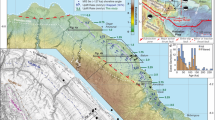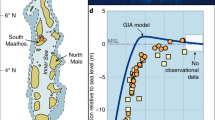Abstract
During the last interglacial period, 127–116 kyr ago, global mean sea level reached a peak of 5–9 m above present-day sea level. However, the exact timing and magnitude of ice sheet collapse that contributed to the sea-level highstand is unclear. Here we explore this timing using stratigraphic and geomorphic mapping and uranium-series geochronology of fossil coral reefs and geophysical modelling of sea-level records from Western Australia. We show that between 127 and 119 kyr ago, eustatic sea level remained relatively stable at about 3–4 m above present sea level. However, stratigraphically younger fossil corals with U-series ages of 118.1±1.4 kyr are observed at elevations of up to 9.5 m above present mean sea level. Accounting for glacial isostatic adjustment and localized tectonics, we conclude that eustatic sea level rose to about 9 m above present at the end of the last interglacial. We suggest that in the last few thousand years of the interglacial, a critical ice sheet stability threshold was crossed, resulting in the catastrophic collapse of polar ice sheets and substantial sea-level rise.
This is a preview of subscription content, access via your institution
Access options
Subscribe to this journal
Receive 12 print issues and online access
$259.00 per year
only $21.58 per issue
Buy this article
- Purchase on Springer Link
- Instant access to full article PDF
Prices may be subject to local taxes which are calculated during checkout




Similar content being viewed by others
References
Lambeck, K. Sea-level change through the last glacial cycle: Geophysical, glaciological and palaeogeographic consequences. Comptes Rendus Geosci. 336, 677–689 (2004).
Peltier, W. R. & Fairbanks, R. G. Global glacial ice volume and Last Glacial Maximum duration from an extended Barbados sea level record. Quat. Sci. Rev. 25, 3322–3337 (2006).
Milne, G. A. & Mitrovica, J. X. Searching for eustasy in deglacial sea-level histories. Quat. Sci. Rev. 27, 2292–2302 (2008).
Mitrovica, J. X. & Milne, G. A. On the origin of late Holocene sea-level highstands within equatorial ocean basins. Quat. Sci. Rev. 21, 2179–2190 (2002).
Dutton, A. & Lambeck, K. Ice volume and sea level during the last interglacial. Science 337, 216–219 (2012).
Kennedy, D. M., Marsters, T. H., Woods, J. L. D. & Woodroffe, C. D. Shore platform development on an uplifting limestone island over multiple sea-level cycles, Niue, South Pacific. Geomorphology 141–142, 170–182 (2012).
Hearty, P. J., Neumann, A. C. & O’Leary, M. Comment on ‘Record of MIS 5 sea-level highstands based on U/Th dated coral terraces of Haiti’ by Dumas et al. [Quaternary International 2006 106–118]. Quat. Int. 162, 205–208 (2007).
Thompson, W. G., Curran, H. A., Wilson, M. A. & White, B. Sea-level oscillations during the last interglacial highstand recorded by Bahamas corals. Nature Geosci. 4, 684–687 (2011).
Lambeck, K., Purcell, A. & Dutton, A. The anatomy of interglacial sea levels: The relationship between sea levels and ice volumes during the Last Interglacial. Earth Planet. Sci. Lett. 315, 1–8 (2011).
Nakada, M. & Lambeck, K. Late Pleistocene and Holocene sea-level change in the Australian region and mantle rheology. Geophys. J. Int. 96, 497–517 (1989).
Raymo, M. E. & Mitrovica, J. X. Collapse of polar ice sheets during the stage 11 interglacial. Nature 483, 453–455 (2012).
Mckay, N. P., Overpeck, J. T. & Otto-Bliesner, B. L. The role of ocean thermal expansion in Last Interglacial sea level rise. Geophys. Res. Lett. 38, L14605 (2011).
Denman, P. D. & van de Graaff, W. Emergent Quaternary marine deposits in the Lake MacLeod area, WA: Western Australia (Geol. Survey Ann. Rept 32–37, 1976).
Veeh, H., Schwebel, D., Van De Graaff, W. J. E. & Denman, P. D. Uranium-series ages of coralline terrace deposits in Western Australia. Aust. J. Earth Sci. 26, 285–292 (1979).
Stirling, C. H., Esat, T. M., Lambeck, K. & Mcculloch, M. T. Timing and duration of the Last Interglacial: Evidence for a restricted interval of widespread coral reef growth. Earth Planet. Sci. Lett. 160, 745–762 (1998).
Lambeck, K. & Nakada, M. Constraints on the age and duration of the last interglacial period and on sea-level variations. Nature 357, 125–128 (1992).
Hearty, P. J., Hollin, J. T., Neumann, A. C., O’Leary, M. J. & McCulloch, M. Global sea-level fluctuations during the Last Interglaciation (MIS 5e). Quat. Sci. Rev. 26, 2090–2112 (2007).
O’Leary, M., Hearty, P. J. & McCulloch, M. T. Geomorphic evidence of major sea-level fluctuations during marine isotope substage-5e, Cape Cuvier, Western Australia. Geomorphology 102, 595–602 (2008).
Rohling, E.J. et al. High rates of sea-level rise during the last interglacial period. Nature Geosci. 1, 38–42 (2008).
Thompson, W. G. & Goldstein, S. L. Open-system coral ages reveal persistent suborbital sea-level cycles. Science 308, 401–404 (2005).
Land, L. S., Mackenzie, F. T. & Gould, S. J. Pleistocene history of Bermuda. Geol. Soc. Am. Bull. 78, 993–1006 (1967).
Hollin, J. T. Thames interglacial sites, Ipswichian sea levels and Antarctic ice surges. Boreas 6, 33–52 (1977).
Neumann, A. C. & Hearty, P. Rapid sea-level changes at the close of the last interglacial (substage 5e) recorded in Bahamian island geology. Geology 24, 775–778 (1996).
Blanchon, P., Eisenhauer, A., Fietzke, J. & Liebetrau, V. Rapid sea-level rise and reef back-stepping at the close of the last interglacial highstand. Nature 458, 881–U6 (2009).
Kopp, R. E., Simons, F. J., Mitrovica, J. X., Maloof, A. C. & Oppenheimer, M. Probabilistic assessment of sea level during the last interglacial stage. Nature 462, 863–U51 (2009).
Dahl-Jensen, D. et al. Eemian interglacial reconstructed from a Greenland folded ice core. Nature 493, 489–494 (2013).
Thompson, W. G., Spiegelman, M., Goldstein, S. L. & Speed, R. An open-system model for U-series age determinations of fossil corals. Earth Planet. Sci. Lett. 210, 365–381 (2003).
Kendall, R. A., Mitrovica, J. X. & Milne, G. A. On post-glacial sea level—II. Numerical formulation and comparative results on spherically symmetric models. Geophys. J. Int. 161, 679–706 (2005).
Peltier, W. R. Global glacial isostasy and the surface of the ice-age Earth: The ICE-5G (VM2) model and GRACE. Annu. Rev. Earth Planet. Sci. 32, 111–149 (2004).
Lambeck, K., Smither, C. & Johnston, P. Sea-level change, glacial rebound and mantle viscosity for northern Europe. Geophys. J. Int. 134, 102–144 (1998).
Mitrovica, J. X. & Forte, A. M. A new inference of mantle viscosity based upon joint inversion of convection and glacial isostatic adjustment data. Earth Planet. Sci. Lett. 225, 177–189 (2004).
Acknowledgements
This study of MIS 5e sea level is the product of more than ten years of research and collaboration among the authors and others not mentioned. We thank Omnistar’s Perth office for providing the global positioning system satellite signal. Our work was also supported by NSF award OCE1202632 to M.E.R., P.J.H., and J.X.M.; NSF awards OCE0602383, EAR0819714 and OCE0902849 to W.G.T.; ARC award DP0209059 to M. McCulloch, P.J.H. and A. Halliday; the Canadian Institute for Advanced Research and Harvard University (J.X.M.); and M. Gagnon, Curtin University.
Author information
Authors and Affiliations
Contributions
M.J.O. contributed to the field mapping and provided the geochronology, including mass spectrometry and age interpretations. He also provided GIA interpretations and wrote the manuscript. P.J.H. contributed to the field mapping and stratigraphic interpretations and assisted in the writing of the manuscript. W.G.T. contributed to the field mapping, provided the geochronology, including mass spectrometry and age interpretations, and assisted in the writing of the manuscript. M.E.R. contributed to the field mapping, provided GIA interpretations and assisted in the writing of the manuscript. J.X.M. carried out the GIA modelling, including interpretations, and assisted in the writing of the manuscript. J.M.W. contributed to stratigraphic and geomorphic field-mapping interpretations.
Corresponding author
Ethics declarations
Competing interests
The authors declare no competing financial interests.
Supplementary information
Supplementary Information
Supplementary Information (PDF 744 kb)
Supplementary Information
Supplementary Information (XLSX 123 kb)
Rights and permissions
About this article
Cite this article
O’Leary, M., Hearty, P., Thompson, W. et al. Ice sheet collapse following a prolonged period of stable sea level during the last interglacial. Nature Geosci 6, 796–800 (2013). https://doi.org/10.1038/ngeo1890
Received:
Accepted:
Published:
Issue Date:
DOI: https://doi.org/10.1038/ngeo1890
This article is cited by
-
Multiple episodes of ice loss from the Wilkes Subglacial Basin during the Last Interglacial
Nature Communications (2023)
-
Influence of reef isostasy, dynamic topography, and glacial isostatic adjustment on sea-level records in Northeastern Australia
Communications Earth & Environment (2023)
-
Benthic δ18O records Earth’s energy imbalance
Nature Geoscience (2023)
-
Wilkes subglacial basin ice sheet response to Southern Ocean warming during late Pleistocene interglacials
Nature Communications (2022)
-
Evidence of wet-dry cycles and mega-droughts in the Eemian climate of southeast Australia
Scientific Reports (2020)



